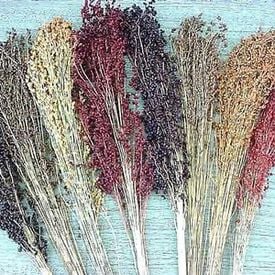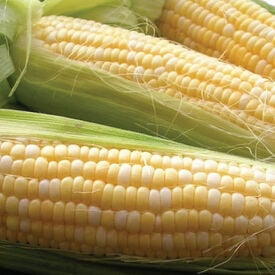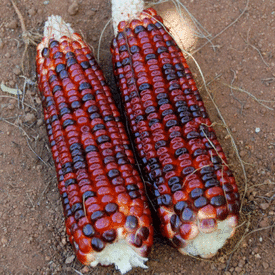Minnesota 13 corn seed is a hybrid variety specifically developed to thrive in the northern climates and shorter growing seasons of regions like Minnesota. This dent corn is renowned for its adaptability and resilience, featuring strong stalks that can withstand harsh weather conditions. With a relatively short maturity period, it offers good yield potential, making it a reliable choice for farmers looking to maximize production. Additionally, Minnesota 13 is bred for resistance to common pests and diseases, ensuring robust growth and high-quality grain. Its versatility allows it to perform well in various soil types, particularly in well-drained, fertile soils, making it a staple in northern Midwest agriculture.
Green Field corn produces an abundance of tall (8-10') stalks with 8-9" long ears. Developed from Reid's Yellow Dent, this corn produces bright yellow, long and narrow 14-kernel row ears. Green Field was the name of the farm that this corn was first produced on. Reported yields of 190 bu/acre in the boot heel area of MO.
Pink Xocoyul corn is a unique heirloom variety from the mountainous regions of Oaxaca, Mexico, renowned for its striking pinkish kernels and its rich, nutty flavor. This Tlaxacaltecan varietal of pink heirloom corn is akin to a Chalqueño, but a bit denser. This traditional corn is often grown in small, family-run farms and is prized for its ability to thrive in high-altitude, temperate climates. While it is traditionally used for atole dulce, a warm, sweet masa beverage, Xocoyul lends itself seamlessly to a variety of masa applications, such as quesadillas with fresh quesillo or festive pink tamales. Beyond its culinary uses, Pink Xocoyul corn is valued for its cultural significance in Oaxacan cuisine, where it plays a central role in regional food traditions. Like many heirloom varieties, it is open-pollinated, making it an excellent choice for sustainable farming and seed-saving. This beautiful corn not only adds vibrant color to dishes but also helps preserve a piece of Mexico's agricultural heritage.
Blue Cónico corn is a beautiful heirloom variety from Mexico, known for its striking blue-purple kernels and conical-shaped ears. This traditional corn is not only visually stunning but also prized for its rich, nutty flavor and excellent texture, which makes it ideal for grinding into masa to create tortillas, tamales, and other staple dishes. The plant is hardy and adaptable, thriving in a variety of climates, especially in higher altitudes, and is well-suited to organic and sustainable farming practices. Blue "Azul" Cónico corn is highly valued for its role in Mexican cuisine, where it adds both flavor and color to a wide range of dishes. As an open-pollinated variety, it is a favorite among farmers and gardeners who value biodiversity and the preservation of heritage crops, ensuring this ancient corn continues to be a significant part of Mexico's agricultural and culinary traditions.
Red Cónico corn is a striking heirloom variety from Mexico, known for its deep red kernels and distinctive conical shape. This traditional corn is prized for its rich, nutty flavor and excellent texture, making it ideal for grinding into masa for tortillas, tamales, or for use in savory dishes like soups and stews. The plant is hardy, thriving in a range of climates, particularly in high-altitude regions, and is often grown in smaller, family-owned farms where it has been cultivated for generations. Red "Rojo" Cónico corn’s deep cultural significance in Mexican cuisine, along with its vibrant color and versatility, make it a favorite for both home gardeners and farmers looking to preserve traditional varieties. Its open-pollinated nature also makes it a great choice for sustainable farming and seed saving.
The Broom Blend is a high yielding, colorful and easy to grow corn that has been used for years in broom making. The vibrant fan-shaped seed heads come in a mix of gold, red, bronze and purple. (Does not produce ears of traditional corn.) The cut and dried mature straw can be used for a variety of crafts and dried arrangements, as well as brooms. Birds will love the seeds, too.
The Double Standard is the first ever bicolor, open-pollinated sweet corn on the market! This variety is an early maturing corn with strong germination in cool soil. The Double Standard was developed to grow well throughout the United States especially in Northern parts. This variety's ears grow up to 7" with 12-14 rows of yellow and white kernels. Double Standard has an excellent traditional corn taste. Its stalks grow to 5' or taller. Certified Organic. Learn more about our organic seeds.
Wapsie Valley heirloom corn is a traditional variety that hails from the Wapsipinicon River Valley in Iowa. Known for its rich history and unique flavor, this heirloom corn features tall, sturdy plants that produce large ears with colorful, often striped kernels ranging from yellow to blue and red. The kernels are prized for their taste and are typically used for making cornmeal, grits, and other culinary applications. Wapsie Valley corn is not just valued for its flavor; it also has good adaptability to different soil types and conditions, often thriving in diverse environments. As an heirloom variety, it is appreciated for its genetic diversity and resilience, making it a popular choice among organic and sustainable farmers. The corn is also sought after by home gardeners and those interested in preserving traditional agricultural practices. Overall, Wapsie Valley heirloom corn represents both a connection to agricultural heritage and a commitment to biodiversity.
Bloody Butcher corn is a striking heirloom variety known for its deep red kernels and bold, rustic flavor. This ancient American corn is traditionally grown for both its ornamental beauty and its culinary versatility. The vibrant red and purple kernels make it an eye-catching addition to any garden, while the corn itself is prized for its dense, starchy texture, which is perfect for grinding into cornmeal, flour, and grits. Bloody Butcher corn is also commonly used in hominy and for popping. Its tall, robust plants are well-suited for a variety of growing conditions, thriving in warm climates with well-drained soil. As an open-pollinated variety, Bloody Butcher is excellent for sustainable farming and seed-saving, ensuring its continued presence in both historical and modern agriculture. This heirloom variety not only adds color and flavor to the kitchen but also carries a rich history, making it a favorite for gardeners and farmers alike.
Yellow Cónico corn is a traditional Mexican heirloom variety known for its distinctive, conical-shaped ears and vibrant yellow kernels. This Yellow Cónico is grown in the highlands of Atlacomulco in Estado de México and produces a light and lovely golden masa. This corn is highly prized for its versatility and excellent texture, making it ideal for a wide range of culinary uses, from making masa for tortillas and tamales to being ground into flour for baking. The plant is hardy and adaptable, thriving in a variety of climates, though it particularly excels in regions with warm temperatures and well-drained soil. The kernels have a slightly sweet, rich flavor that stands out in both savory and sweet dishes. Yellow "Amarillo" Cónico corn has deep cultural significance in Mexico, where it has been grown for centuries, and its open-pollinated nature makes it an excellent choice for sustainable farming practices. Whether grown for food or as part of a seed-saving program, Yellow Cónico corn continues to be a cherished variety for its unique taste and historical roots.
Cherokee White Eagle corn is a traditional heirloom variety cherished for its striking appearance and cultural significance. This variety features tall plants that produce long ears adorned with white, plump kernels, which can sometimes have a slight yellow or cream tint. Known for its excellent flavor, Cherokee White Eagle corn is often used in a variety of culinary applications, including grits, cornmeal, and even as fresh sweet corn. Its kernels are particularly valued for their sweetness and unique texture. This corn variety has deep roots in Native American agriculture, particularly among the Cherokee people, where it has been cultivated for generations. Its resilience to various growing conditions makes it a reliable choice for both home gardeners and small-scale farmers. Cherokee White Eagle corn not only serves as a staple food source but also plays an important role in cultural traditions and ceremonies. Its rich history and versatility in the kitchen make it a treasured heirloom variety among those who appreciate heritage crops.
Truckers Favorite Yellow is an heirloom yellow dent field corn that is excellent for roasting or frying or used as a dent. This variety stays fresh for a long time. Truckers Favorite Yellow stalks are 8-9' tall and ears are 8-10" and have 14-18 rows. This corn has high yields with good soil fertilization and is an excellent foliage for early fodder.












